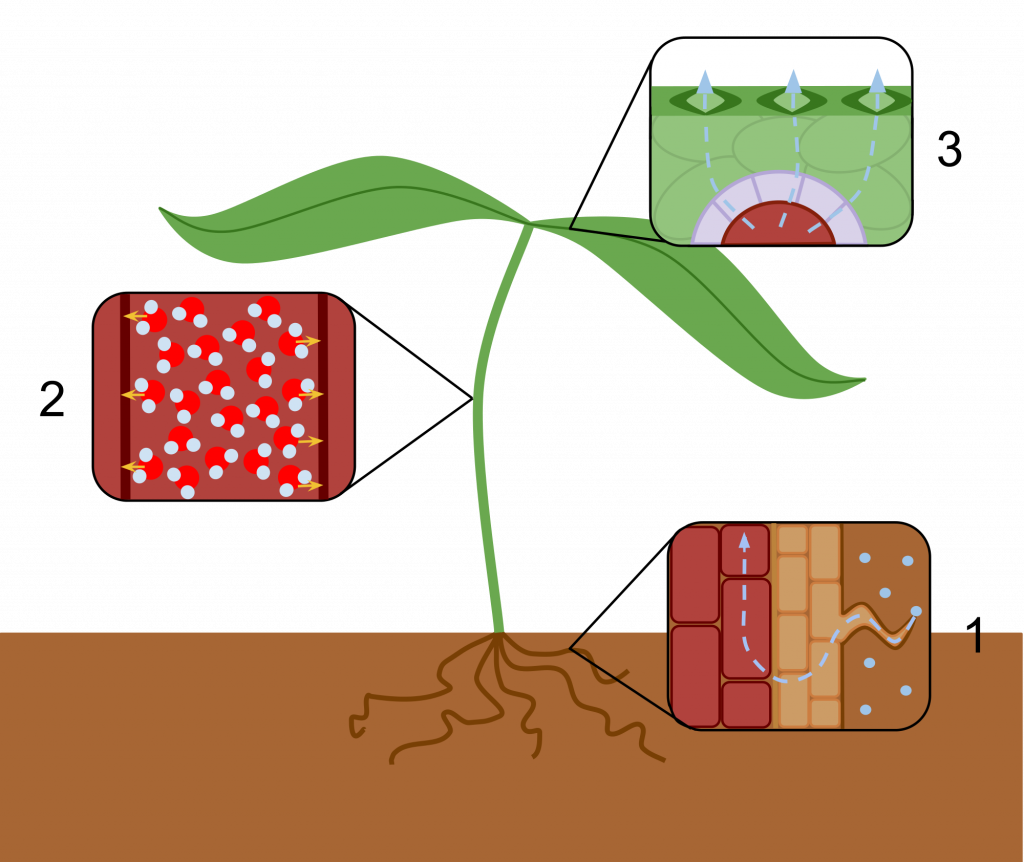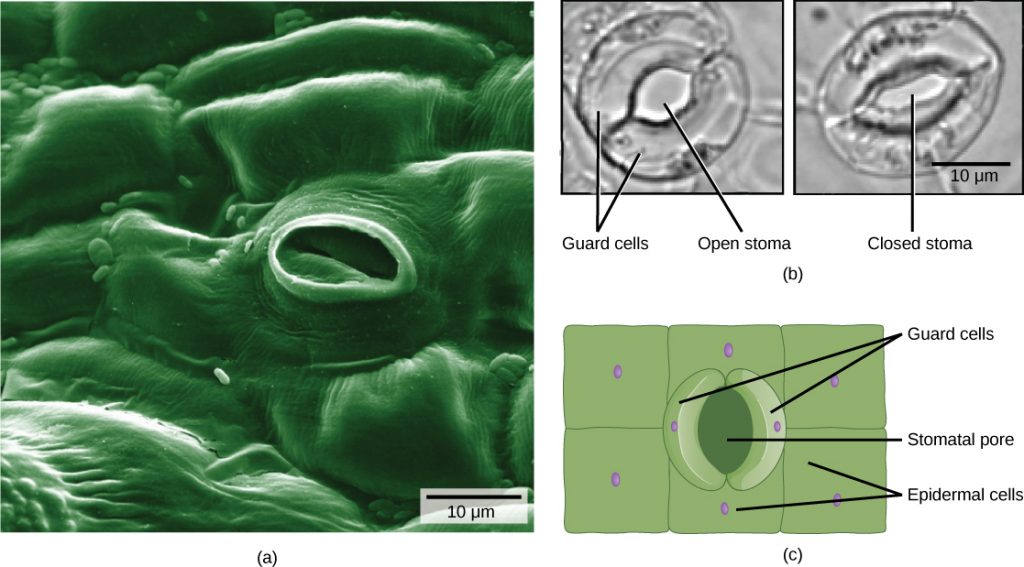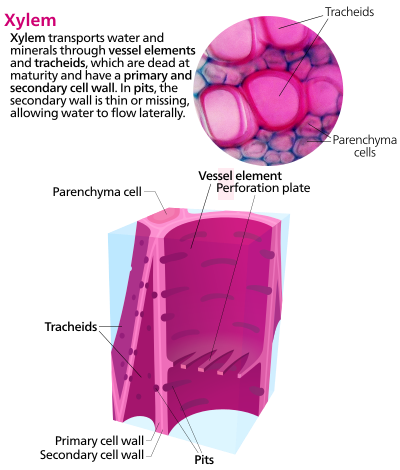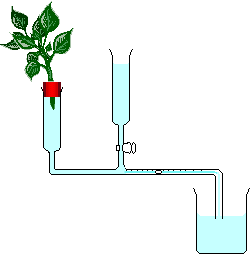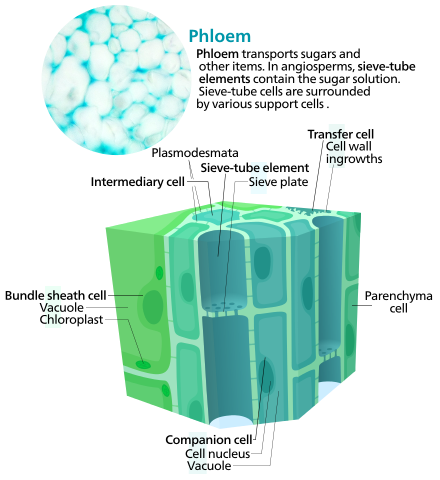Contents
Mass Transport in Plants
The Movement of Water
The main substances transported en masse in plants are water and organic substances. These are transported by either the xylem or phloem, which collectively are described as the vascular bundle.
Water is first absorbed by osmosis via the root hair cells, which are adapted to maximize osmosis by having thin walls and a large surface area. Once this water reaches the xylem, it is transported through the xylem's hollow, thick-walled tubes to the rest of the plant. It is possible for the water to move in one direction, typically against gravity, due to water transpiring from the leaves and creating a pulling force on the water left in the plant.
Transpiration is the evaporation of water through the stomata, typically on leaves.
As evaporation is the conversion of liquid water to water vapor, an increase in temperature will speed up this process as the water molecules gain more kinetic energy to move. If the surrounding air is less humid or there is a lot of wind to carry away evaporating water molecules, then transpiration will occur faster due to a greater concentration gradient.
Plants are able to control this water loss, as stomata opening is controlled by cells called guard cells. Guard cells swell and bend when the plant has a lot of water, resulting in the stomata opening. While water will evaporate out, carbon dioxide can also diffuse in for photosynthesis. Stomata open more when it is light and the plant cells are turgid.
Cohesion-Tension Theory
The movement of water up the xylem links to the properties of water learned in topic 1. Due to the dipolar nature of water, it forms hydrogen bonds between water molecules, creating cohesion. This cohesion results in water forming a continuous column in the plant stem. Tension, or a pulling force, is created when the water evaporates out of the stomata. This movement of water out of the stomata results in the water column being pulled up the xylem towards the stomata, known as the transpiration pull. This pull will draw up the water and also put tension on the xylem, making it narrow and longer. This change in diameter of the xylem is measurable; for example, the diameter of tree trunks will change according to transpiration rates.
Xylem cells are adapted to form this continuous water column as they are hollow cells. They are hollow because they are dead cells that do not contain any organelles, and they have no end walls, enabling a column to form.
Measuring Transpiration
A potometer measures the rate of transpiration and can therefore be used to investigate the effect of a named environmental variable on the rate of transpiration.
A sample of a plant must be cut from a plant underwater. This is to prevent any air from entering the xylem and breaking the water column. The potometer is filled with water, and all air bubbles are removed. The cut leafy plant is then attached to the potometer, using rubber seals and petroleum jelly to make the equipment airtight. One air bubble is then introduced into the equipment, and the distance that this air bubble has moved towards the plant is recorded. To convert this into an estimate of transpiration rate, the distance the bubble moved can be used to work out the volume of water in the tube that evaporated. This volume is divided by the time it took to lose that volume of water to get a rate. This apparatus can be reset, and different conditions can be applied to the leaf to see if the rate changes. For example, a lamp could be used to replicate sunlight, a fan may be applied to replicate wind, or a plastic bag over the plant to increase humidity.
Transport of Organic Substances
Phloem is the tube responsible for transporting organic substances in plants, such as sugars. This transport is called translocation and is explained by the mass flow hypothesis. Phloem tissue is made up of different cells. One cell type is the sieve tube elements, which are long and thin and arranged as a column. The name "sieve" is used to describe the fact that the end walls are perforated, like a sieve. Next to these cells are companion cells.
Translocation
Organic molecules, such as sucrose, are created in the leaves by photosynthesis. The sucrose is transported by facilitated diffusion into the companion cells, down a concentration gradient. For the sucrose to enter the sieve tube elements for mass transport around the plant, there is a co-transport protein involving hydrogen ions. Therefore, hydrogen ions must first be actively transported from the companion cells into the space between the cells to create a concentration gradient. The hydrogen ions can then transport into the sieve tube elements down a concentration gradient, attaching to the co-transport carrier protein. The sucrose molecules will also bind to the co-transport molecules and be moved into the sieve tube element cell. Once the sucrose is transported into the sieve tube cells, they will only move en masse if there are changes in pressure. This pressure is created by varying water potentials (the pressure of water-based solutions). The movement of the sucrose into the sieve tube elements will create a more negative water potential, whereas the xylem directly next to the phloem will have a far more positive water potential. As a result, water will move from the xylem into the phloem by osmosis.
This increase in volume will create a high hydrostatic pressure (pressure created by large volumes of liquid). At respiring cells, sugars are being used up, and therefore sucrose will constantly be transported into them to maintain respiration rates. This, in turn, lowers the water potential of respiring cells. Water dissolved in the phloem sugar solutions will move by osmosis into these respiring cells, decreasing the hydrostatic pressure in the phloem. Therefore, a pressure gradient is created: a higher hydrostatic pressure near the leaves and a lower hydrostatic pressure near respiring cells, causing the solution in the phloem to move towards respiring cells.
Transport in plants can be investigated by using tracers and ringing experiments. To prove that the phloem carries the sugars and xylem carries the water, two experiments were done.
Ringing
This is when a ring of bark and phloem are peeled and removed from a tree trunk. The result of removing the phloem was that the trunk swelled above the removed section. When the liquid in this swelling was analyzed, it was shown to contain sugar. This shows that when the phloem was removed, the sugars could not be transported and therefore proved that the phloem transports sugars.
Tracing
The second method involved radioactive labeling of carbon. Plants were provided with only radioactively labeled carbon dioxide. Over time, this is absorbed and used in photosynthesis to create sugars that are all radioactively labeled. Thin slices from the stems were then cut and placed on x-ray film that turns black when exposed to radioactive material. When the stems were placed on the x-ray film, the section of the stem containing the sugars turned black, highlighting where the phloem was located.
- At what time of the day would you expect transpiration rates to be highest?
- Midday
- At what time of the day would you expect the diameter of a tree to be the smallest?
- Midday
- What property of water results in cohesion and the continuous water column?
- Dipolar
- What are the two cells that make up phloem tissue?
- Your answer should include: companion / cells / sieve / tube

